Grafting ‘Red Globe’ (Vitis vinifera) onto Multiple Rootstocks: A Systematic, Multi-Year Evaluation Focusing on Graft Compatibility, Vegetative Growth, and Fruit Characteristics
Abstract
1. Introduction
2. Materials and Methods
2.1. Plant Materials and Grafting Details
2.2. Healing and Growth Evaluation of Grafts
2.3. Survival Rate and Graft Compatibility Evaluation Under Field Conditions
2.4. Growth Evaluation Under Field Conditions
2.5. Determination of Fruit-Related Traits
2.6. Statistical Analysis
3. Results
3.1. Graft Healing and Growth Indicators of ‘Red Globe’ Graft Combinations
3.2. Field Survival Rate of ‘Red Globe’ Grafting Combinations
3.3. Graft Compatibility of ‘Red Globe’ Grafting Combinations as Indicated by Field Growth
3.4. Vegetative Growth of ‘Red Globe’ Grafting Combinations
3.5. Fruit Morphology Characteristics of ‘Red Globe’ Grafting Combinations
3.6. Berry Texture and Taste-Related Traits of ‘Red Globe’ Grafting Combinations
3.7. Comprehensive Characteristics of ‘Red Globe’ Grafting Combinations
4. Discussion
5. Conclusions
Supplementary Materials
Author Contributions
Funding
Data Availability Statement
Conflicts of Interest
References
- Lo’ay, A.A.; El-Ezz, S.F.A. Performance of ‘Flame seedless’ grapevines grown on different rootstocks in response to soil salinity stress. Sci. Hortic. 2021, 275, 109704. [Google Scholar] [CrossRef]
- Marcuzzo, P.; Masiero, L.; Mian, G.; Belfiore, N.; Romano, A.; Lovat, L.; Gaiotti, F.; Ristic, R. Assessing the effect of different grapevine rootstocks as a strategy to maintain the yield and quality of Vitis vinifera L. cv. “Glera” under a warming climate. Aust. J. Grape Wine Res. 2025, 2025, 3916510. [Google Scholar] [CrossRef]
- Monteiro, H.S.A.; Tecchio, M.A.; Brito, S.d.N.S.; Neto, F.J.D.; Sánchez, C.A.P.C.; Alonso, J.C.; Feliciano, D.E.F.; Maniero, C.R.; Cunha, P.H.H.; Silva, M.d.S. Phenological development, thermal requirement, and quality of ‘BRS Núbia’ (Vitis vinifera L. × Vitis labrusca L.) grapes on different rootstocks. Horticulturae 2025, 11, 466. [Google Scholar] [CrossRef]
- Migicovsky, Z.; Cousins, P.; Jordan, L.M.; Myles, S.; Striegler, R.K.; Verdegaal, P.; Chitwood, D.H. Grapevine rootstocks affect growth-related scion phenotypes. Plant Direct 2021, 5, e00324. [Google Scholar] [CrossRef]
- Li, M.; Guo, Z.; Jia, N.; Yuan, J.; Han, B.; Yin, Y.; Sun, Y.; Liu, C.; Zhao, S. Evaluation of eight rootstocks on the growth and berry quality of ‘Marselan’ grapevines. Sci. Hortic. 2019, 248, 58–61. [Google Scholar] [CrossRef]
- Kidman, C.M.; Dry, P.R.; McCarthy, M.G.; Collins, C. Reproductive performance of Cabernet Sauvignon and Merlot (Vitis vinifera L.) is affected when grafted to rootstocks. Aust. J. Grape Wine Res. 2013, 19, 409–421. [Google Scholar] [CrossRef]
- Zhou, Q.; Gao, B.; Li, W.-F.; Mao, J.; Yang, S.-J.; Li, W.; Ma, Z.-H.; Zhao, X.; Chen, B.-H. Effects of exogenous growth regulators and bud picking on grafting of grapevine hard branches. Sci. Hortic. 2020, 264, 109186. [Google Scholar] [CrossRef]
- Kodur, S.; Tisdall, J.M.; Clingeleffer, P.R.; Walker, R.R. Regulation of berry quality parameters in ‘Shiraz’ grapevines through rootstocks (Vitis). Vitis 2013, 52, 125–128. [Google Scholar]
- Hanana, M.; Hamed, K. Influence of the rootstock/scion combination on the grapevine’s behavior under salt stress. J. Plant Biochem. Physiol. 2015, 3, 1000154. [Google Scholar] [CrossRef]
- Walker, M.A.; Lund, K.; Agüero, C.; Riaz, S.; Fort, K.; Heinitz, C.; Romero, N. Breeding grape rootstocks for resistance to phylloxera and nematodes—It’s not always easy. Acta Hortic. 2014, 1045, 89–97. [Google Scholar] [CrossRef]
- Jin, Z.; Sun, H.; Sun, T.; Wang, Q.; Yao, Y. Modifications of ‘Gold Finger’ grape berry quality as affected by the different rootstocks. J. Agric. Food. Chem. 2016, 64, 4189–4197. [Google Scholar] [CrossRef]
- Yin, Y.; Jia, N.; Li, M.; Liu, C.; Yuan, J.; Han, B.; Sun, Y.; Zhao, S.; Guo, Z. Rootstocks induce shifts in tree vigor, yield and berry quality of ‘Summer Black’ grapevines. Eur. J. Hortic. Sci. 2021, 86, 41–48. [Google Scholar] [CrossRef]
- Jia, N.; Yin, Y.; Li, M.; Yuan, J.; Liu, C.; Han, B.; Sun, Y.; Zhao, S.; Guo, Z. Yield and fruit quality evaluation of ‘Yueguangwuhe’ grapes (Vitis vinifera × V. labrusca) grafted on different rootstocks. J. Am. Pomol. Soc. 2020, 74, 274–283. [Google Scholar]
- Zhang, F.; Zhong, H.; Zhou, X.; Pan, M.; Xu, J.; Liu, M.; Wang, M.; Liu, G.; Xu, T.; Wang, Y.; et al. Grafting with rootstocks promotes phenolic compound accumulation in grape berry skin during development based on integrative multi-omics analysis. Hortic. Res 2022, 9, uhac055. [Google Scholar] [CrossRef]
- Munoz, J.R.; Stauch, S.J.; Wootten, J.; Kitchen, M.; Abreu, M.; Rodriguez, C.J.; Casassa, L.F.; Wolpert, J.A.; Dodson Peterson, J.C. Effect of rootstock on vineyard establishment using green-growing benchgrafts. Agronomy 2023, 13, 1586. [Google Scholar] [CrossRef]
- Cheng, J.; Li, H.; Wang, W.; Duan, C.; Wang, J.; He, F. The influence of rootstocks on the scions’ aromatic profiles of Vitis vinifera L. cv. Chardonnay. Sci. Hortic. 2020, 272, 109517. [Google Scholar] [CrossRef]
- Gautier, A.T.; Chambaud, C.; Brocard, L.; Ollat, N.; Gambetta, G.A.; Delrot, S.; Cookson, S.J. Merging genotypes: Graft union formation and scion-rootstock interactions. J. Exp. Bot. 2019, 70, 747–755. [Google Scholar] [CrossRef]
- Sivritepe, N.; Sivritepe, H.O.; Celik, H.; Katkat, A.V. Salinity responses of grafted grapevines: Effects of scion and rootstock genotypes. Not. Bot. Hort. Agrobot. Cluj 2010, 38, 193–201. [Google Scholar]
- Loupit, G.; Fonayet, J.V.; Prigent, S.; Prodhomme, D.; Spilmont, A.S.; Hilbert, G.; Franc, C.; De Revel, G.; Richard, T.; Ollat, N.; et al. Identifying early metabolite markers of successful graft union formation in grapevine. Hortic. Res 2022, 9, uhab070. [Google Scholar] [CrossRef]
- Ferlito, F.; Distefano, G.; Gentile, A.; Allegra, M.; Lakso, A.N.; Nicolosi, E. Scion–rootstock interactions influence the growth and behaviour of the grapevine root system in a heavy clay soil. Aust. J. Grape Wine Res. 2019, 26, 68–78. [Google Scholar] [CrossRef]
- USDA. Fresh Apples, Grapes, and Pears: World Markets and Trade. 2024. Available online: https://fas.usda.gov/sites/default/files/2024-12/fruit.pdf (accessed on 18 June 2024).
- Aurand, J.-M.; Gargin, S.; Altindisli, A. A Research on the affinity coefficients of Red Globe grape variety with 140 R, 41 B rootstocks. BIO Web Conf. 2014, 3, 01004. [Google Scholar] [CrossRef]
- KamiloĞLu, Ö. Impact of rootstocks on fruit quality, mineral nutrition and leaf physiology of ‘Red Globe’in the East Mediterranean region. Appl. Ecol. Environ. Res. 2022, 20, 4363–4376. [Google Scholar] [CrossRef]
- Sultan, M. Effect of rootstocks on growth, yield and fruit quality of Red Globe grape. Ann. Agric. Sci. Moshtohor 2016, 54, 339–344. [Google Scholar] [CrossRef]
- Coombe, B.G. Growth stages of the grapevine: Adoption of a system for identifying grapevine growth stages. Aust. J. Grape Wine Res. 1995, 1, 104–110. [Google Scholar] [CrossRef]
- Zhu, X.; Li, X.; Jiu, S.; Zhang, K.; Wang, C.; Fang, J. Analysis of the regulation networks in grapevine reveals response to waterlogging stress and candidate gene-marker selection for damage severity. R. Soc. Open Sci. 2018, 5, 172253. [Google Scholar] [CrossRef] [PubMed]
- Jogaiah, S.; Porika, H.; Upreti, K. Biochemical and histological basis of graft compatibility in Red Globe grapes (Vitis Vinifera L) grafted on different rootstocks. Mod. Concep. Dev. Agron. 2021, 9, 896–901. [Google Scholar] [CrossRef]
- Verma, S.K.; Singh, S.K.; Krishna, H. The effect of certain rootstocks on the grape cultivar ‘Pusa Urvashi’ (Vitis vinifera L.). Int. J. Fruit Sci 2010, 10, 16–28. [Google Scholar] [CrossRef]
- Tedesco, S.; Pina, A.; Fevereiro, P.; Kragler, F. A phenotypic search on graft compatibility in grapevine. Agronomy 2020, 10, 706. [Google Scholar] [CrossRef]
- Wang, Y.; Chen, W.; Gao, X.; He, L.; Yang, X.; He, F.; Duan, C.; Wang, J. Rootstock-mediated effects on Cabernet Sauvignon performance: Vine growth, berry ripening, flavonoids, and aromatic profiles. Int. J. Mol. Sci. 2019, 20, 401. [Google Scholar] [CrossRef]
- Schmid, J.; Manty, F.; Huber, L.; Porten, M.; Ruehl, E. Experience with rootstock varieties in Germany. In Proceedings of the 2005 Rootstocks Symposium–Grapevine Rootstocks: Current Use, Research, and Application, Osage Beach, MO, USA, 5 February 2005; pp. 14–24. [Google Scholar]
- Provost, C.; Campbell, A.; Dumont, F. Rootstocks impact yield, fruit composition, nutrient deficiencies, and winter survival of hybrid cultivars in Eastern Canada. Horticulturae 2021, 7, 237. [Google Scholar] [CrossRef]
- Wang, X.; Zhang, G.; Sun, L.; Yan, A.; Wang, H.; Ren, J.; Xu, H. Effects of different rootstocks on the growth and endogenous hormones for grape cultivars. Acta. Hortic. Sin. 2020, 47, 2107–2120. [Google Scholar] [CrossRef]
- Köse, B.; Karabulut, B.; Ceylan, K. Effect of rootstock on grafted grapevine quality. Eur. J. Hortic. Sci. 2014, 79, 197–202. [Google Scholar] [CrossRef]
- Walker, R.R.; Blackmore, D.H. Potassium concentration and pH inter-relationships in grape juice and wine of Chardonnay and Shiraz from a range of rootstocks in different environments. Aust. J. Grape Wine Res. 2012, 18, 183–193. [Google Scholar] [CrossRef]
- Tandonnet, J.P.; Cookson, S.J.; Vivin, P.; Ollat, N. Scion genotype controls biomass allocation and root development in grafted grapevine. Aust. J. Grape Wine Res. 2009, 16, 290–300. [Google Scholar] [CrossRef]
- Yin, Y.; Han, B.; Li, M.; Jia, N.; Liu, C.; Sun, Y.; Wang, Y.; Gao, Q.; Guo, Z. Multiplication, phenological period and growth vigor of thirty-one grapevine rootstocks and the role of parentage in vigor heredity. Horticulturae 2023, 9, 241. [Google Scholar] [CrossRef]
- Li, M.; Yan, X.; Guo, Z.; Jia, N.; Yuan, J.; Han, B.; Yin, Y.; Sun, Y.; Liu, C.; Zhao, S. Rootstock influence on vegetative growth, yield, and fruit quality of ‘Petit Verdot’. Eur. J. Hortic. Sci. 2019, 84, 343–349. [Google Scholar] [CrossRef]
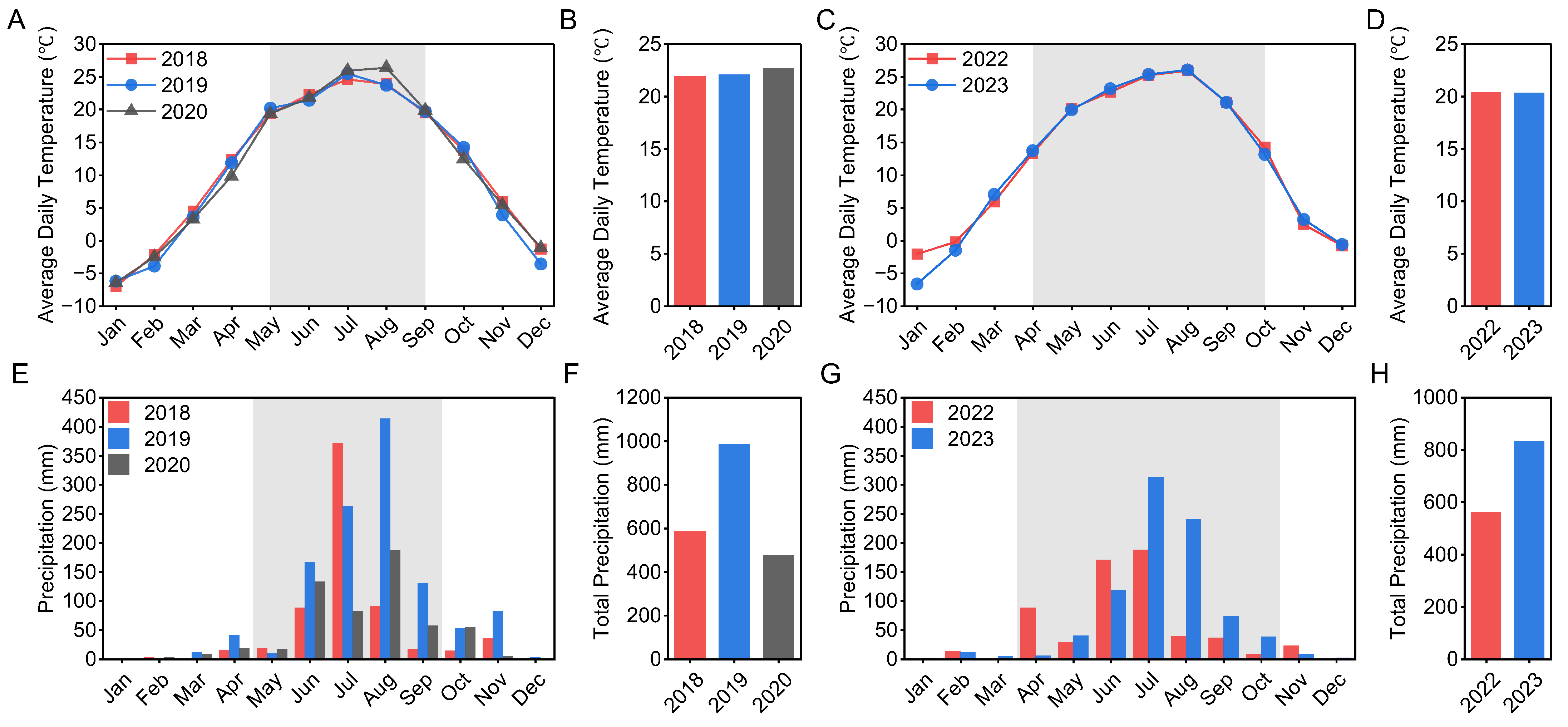
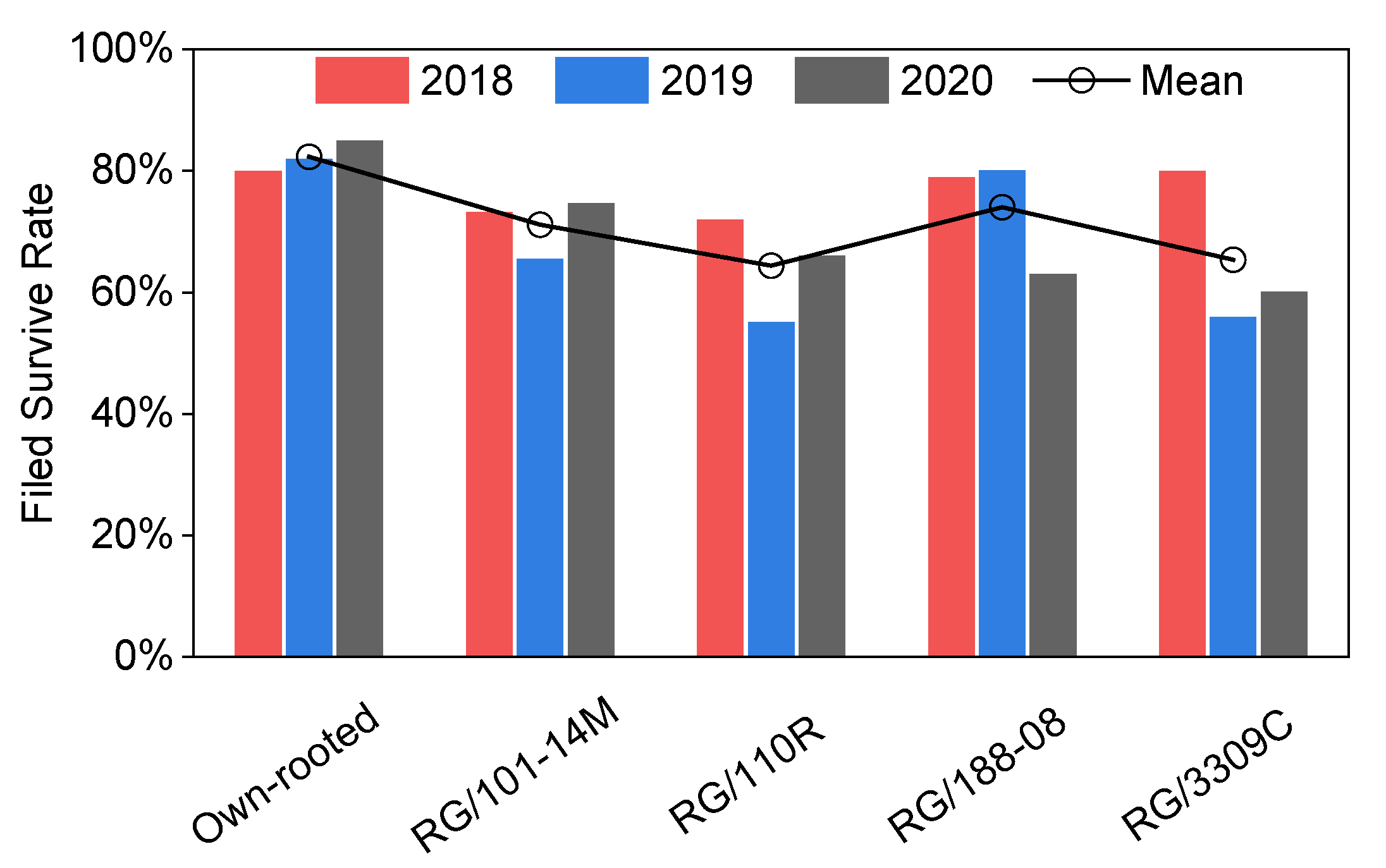
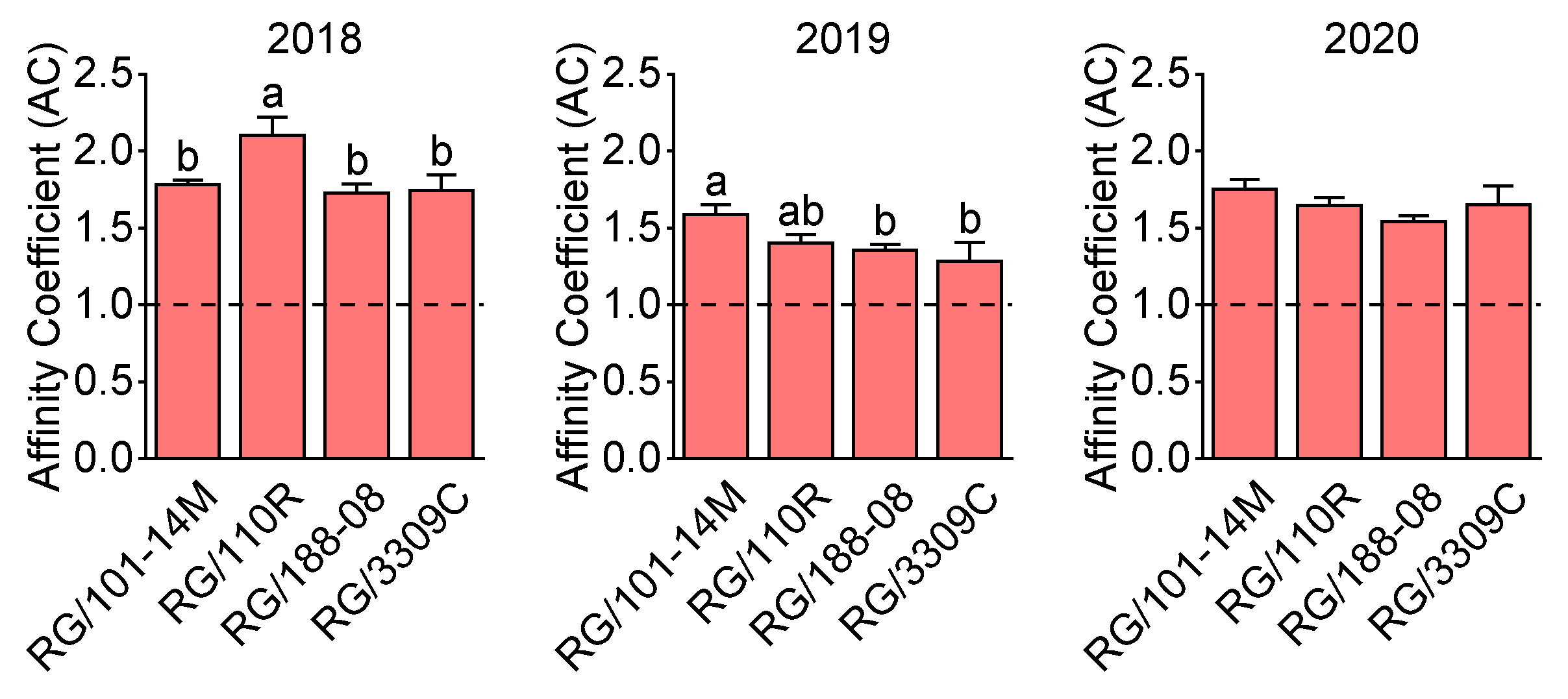
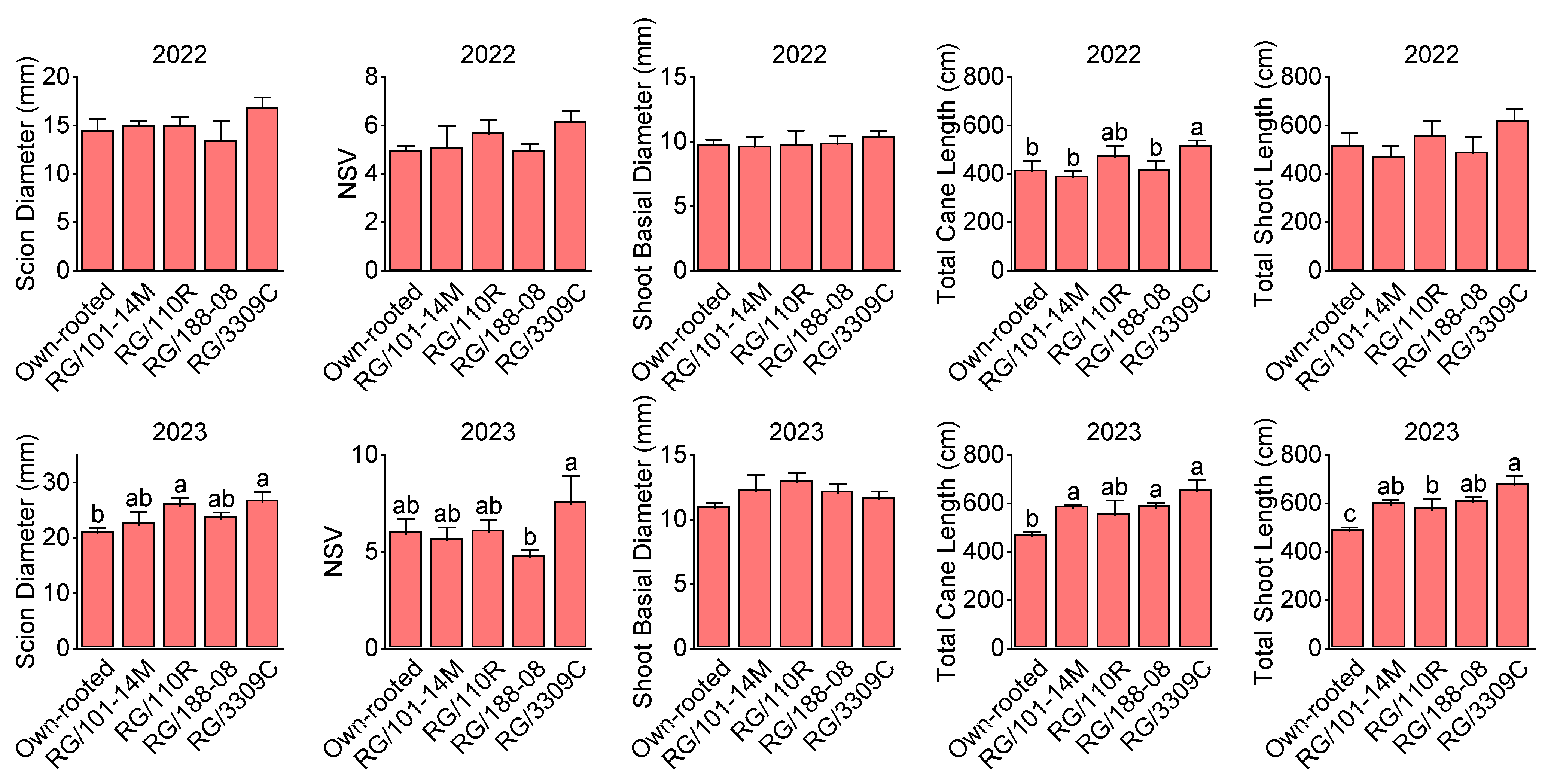
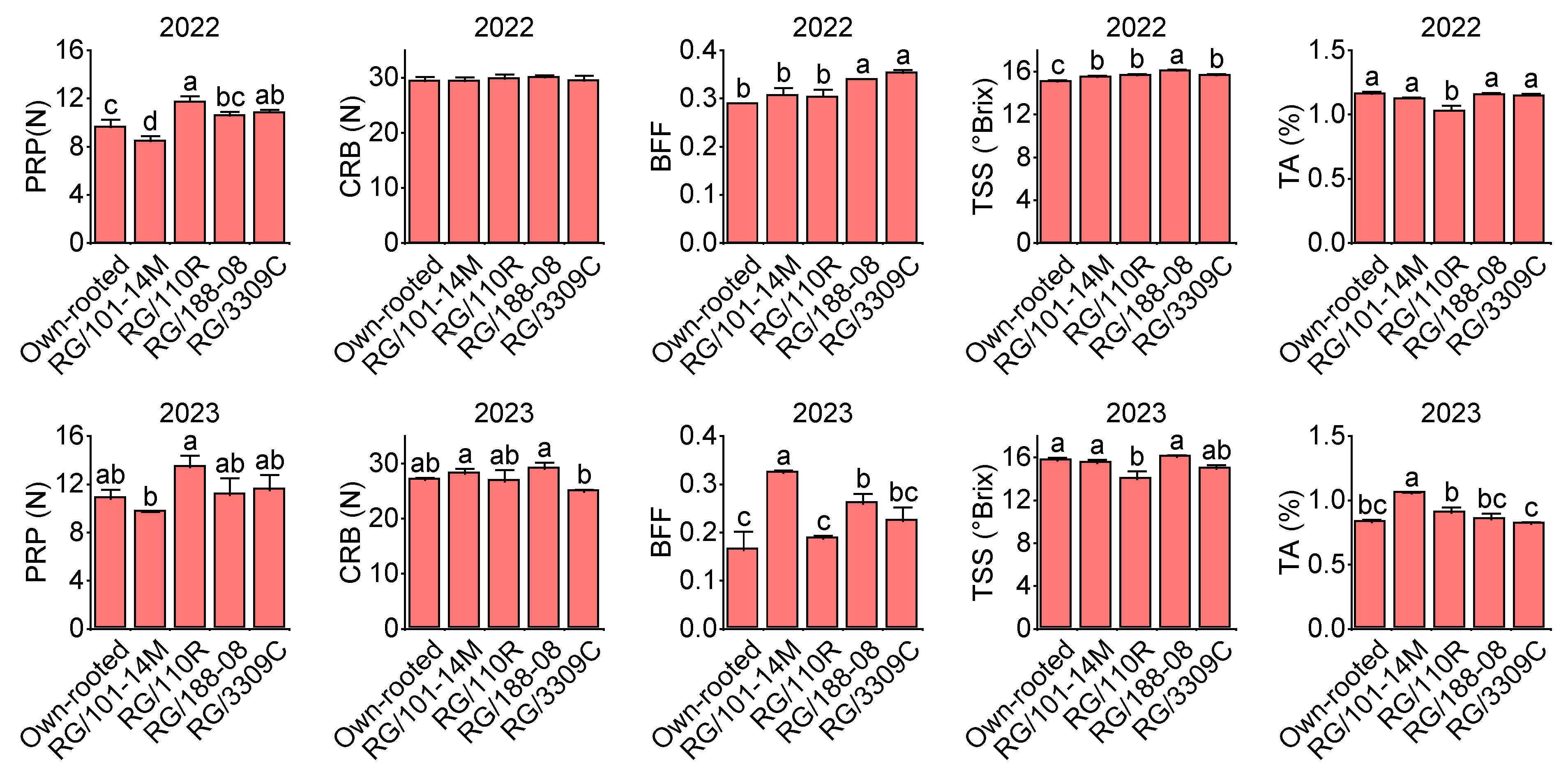
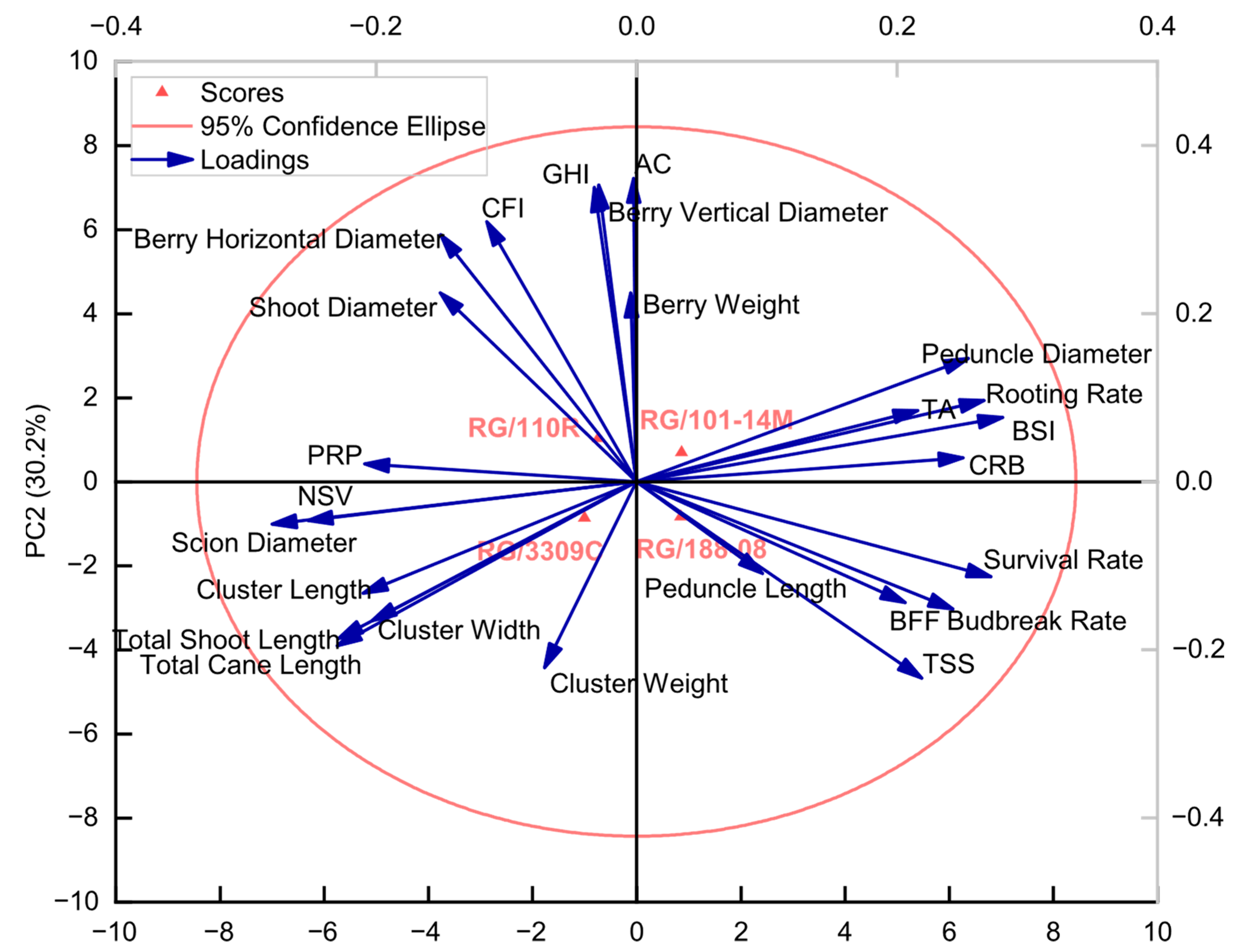
| Year | Graft Combination | GHI | CFI | Budbreak Rate % | Rooting Rate % |
|---|---|---|---|---|---|
| 2018 | RG/101-14M | 0.63 ± 0.05 b | 0.86 ± 0.07 ab | 75.0 ± 10.0 | 10.0 ± 8.2 ab |
| RG/110R | 0.78 ± 0.05 a | 0.98 ± 0.04 a | 62.5 ± 5.0 | 32.5 ± 9.6 a | |
| RG/188-08 | 0.48 ± 0.05 c | 0.79 ± 0.11 b | 69.3 ± 3.8 | 20.5 ± 19.8 ab | |
| RG/3309C | 0.70 ± 0.00 ab | 0.99 ± 0.01 a | 65.0 ± 5.8 | 5.0 ± 5.8 b | |
| 2019 | RG/101-14M | 0.44 ± 0.06 a | 0.53 ± 0.09 a | 52.5 ± 5.0 b | 32.5 ± 15.0 ab |
| RG/110R | 0.35 ± 0.05 ab | 0.50 ± 0.10 ab | 36.6 ± 5.9 c | 17.0 ± 7.8 bc | |
| RG/188-08 | 0.31 ± 0.09 b | 0.28 ± 0.05 c | 67.5 ± 5.0 a | 42.5 ± 9.6 a | |
| RG/3309C | 0.26 ± 0.03 b | 0.35 ± 0.04 bc | 37.5 ± 5.0 c | 7.5 ± 9.6 c | |
| 2020 | RG/101-14M | 0.61 ± 0.06 a | 0.89 ± 0.06 a | 67.5 ± 5.0 b | 70.0 ± 16.3 a |
| RG/110R | 0.58 ± 0.03 ab | 0.92 ± 0.08 a | 82.5 ± 5.0 a | 27.5 ± 9.6 b | |
| RG/188-08 | 0.45 ± 0.08 bc | 0.43 ± 0.03 c | 77.5 ± 5.0 a | 52.5 ± 5.0 a | |
| RG/3309C | 0.39 ± 0.08 c | 0.67 ± 0.07 b | 80.0 ± 0.0 a | 20.0 ± 0.0 b |
| Graft Combinations | Cluster Weight (g) | Cluster Length (cm) | Cluster Width (cm) | Single Berry Weight (g) | Berry Vertical Diameter (mm) | Berry Transverse Diameter (mm) | BSI | Peduncle Length (mm) | Peduncle Diameter (m) | |
|---|---|---|---|---|---|---|---|---|---|---|
| 2022 | Own-rooted | 647.9 ± 152.4 | 19.3 ± 1.5 | 13.3 ± 2.1 | 12.8 ± 0.38 ab | 30.5 ± 0.7 a | 26.5 ± 0.5 a | 1.2 ± 0.04 | 9.2 ± 0.4 a | 3.2 ± 0.02 c |
| RG/101-14M | 656.8 ± 261.5 | 19.7 ± 4.5 | 12.3 ± 1.5 | 11.7 ± 0.20 bc | 28.6 ± 0.5 bc | 25.0 ± 0.4 bc | 1.1 ± 0.02 | 7.9 ± 0.2 bc | 3.7 ± 0.09 a | |
| RG/110R | 684.2 ± 214.2 | 18.7 ± 4.2 | 13.0 ± 1.0 | 13.6 ± 0.10 a | 29.7 ± 0.2 ab | 26.5 ± 0.3 a | 1.1 ± 0.02 | 8.7 ± 0.3 ab | 3.4 ± 0.08 ab | |
| RG/188-08 | 723.0 ± 166.3 | 20.3 ± 2.5 | 12.7 ± 1.5 | 12.5 ± 0.44 ab | 27.9 ± 0.7 c | 24.6 ± 0.5 c | 1.1 ± 0.03 | 9.7 ± 0.5 a | 3.5 ± 0.34 ab | |
| RG/3309C | 664.1 ± 133.4 | 20.0 ± 3.5 | 12.0 ± 2.0 | 11.1 ± 0.68 c | 28.5 ± 0.3 bc | 26.0 ± 0.6 ab | 1.1 ± 0.02 | 7.5 ± 0.5 c | 3.1 ± 0.09 c | |
| 2023 | Own-rooted | 601.1 ± 79.1 | 22.7 ± 1.5 | 12.3 ± 1.5 | 12.2 ± 0.12 a | 27.8 ± 0.7 ab | 26.3 ± 0.9 ab | 1.1 ± 0.03 | 11.1 ± 0.7 | 2.5 ± 0.16 a |
| RG/101-14M | 581.1 ± 100.2 | 21.7 ± 3.1 | 12.7 ± 1.2 | 11.1 ± 0.06 b | 28.9 ± 0.9 ab | 25.8 ± 1.4 ab | 1.1 ± 0.04 | 10.2 ± 0.4 | 2.3 ± 0.15 ab | |
| RG/110R | 747.7 ± 65.2 | 24.3 ± 0.6 | 15.0 ± 1.0 | 12.4 ± 0.08 a | 29.6 ± 1.2 a | 27.2 ± 0.6 a | 1.1 ± 0.07 | 10.6 ± 1.1 | 2.3 ± 0.23 ab | |
| RG/188-08 | 810.4 ± 219.2 | 22.3 ± 4.2 | 15.0 ± 1.0 | 11.4 ± 0.09 b | 27.7 ± 0.9 ab | 24.9 ± 0.6 b | 1.1 ± 0.02 | 10.9 ± 0.2 | 2.5 ± 0.09 a | |
| RG/3309C | 776.6 ± 192.7 | 23.0 ± 1.7 | 16.3 ± 3.5 | 10.3 ± 0.19 c | 26.8 ± 0.7 b | 24.4 ± 0.2 b | 1.1 ± 0.03 | 10.8 ± 0.3 | 2.0 ± 0.03 b |
Disclaimer/Publisher’s Note: The statements, opinions and data contained in all publications are solely those of the individual author(s) and contributor(s) and not of MDPI and/or the editor(s). MDPI and/or the editor(s) disclaim responsibility for any injury to people or property resulting from any ideas, methods, instructions or products referred to in the content. |
© 2025 by the authors. Licensee MDPI, Basel, Switzerland. This article is an open access article distributed under the terms and conditions of the Creative Commons Attribution (CC BY) license (https://creativecommons.org/licenses/by/4.0/).
Share and Cite
Yin, Y.; Yuan, J.; Jia, N.; Li, M.; Liu, C.; Sun, Y.; Wang, X.; Han, S.; Gao, Q.; Liu, S.; et al. Grafting ‘Red Globe’ (Vitis vinifera) onto Multiple Rootstocks: A Systematic, Multi-Year Evaluation Focusing on Graft Compatibility, Vegetative Growth, and Fruit Characteristics. Horticulturae 2025, 11, 1006. https://doi.org/10.3390/horticulturae11091006
Yin Y, Yuan J, Jia N, Li M, Liu C, Sun Y, Wang X, Han S, Gao Q, Liu S, et al. Grafting ‘Red Globe’ (Vitis vinifera) onto Multiple Rootstocks: A Systematic, Multi-Year Evaluation Focusing on Graft Compatibility, Vegetative Growth, and Fruit Characteristics. Horticulturae. 2025; 11(9):1006. https://doi.org/10.3390/horticulturae11091006
Chicago/Turabian StyleYin, Yonggang, Junwei Yuan, Nan Jia, Minmin Li, Changjiang Liu, Yan Sun, Xinyu Wang, Shuli Han, Qian Gao, Shiyuan Liu, and et al. 2025. "Grafting ‘Red Globe’ (Vitis vinifera) onto Multiple Rootstocks: A Systematic, Multi-Year Evaluation Focusing on Graft Compatibility, Vegetative Growth, and Fruit Characteristics" Horticulturae 11, no. 9: 1006. https://doi.org/10.3390/horticulturae11091006
APA StyleYin, Y., Yuan, J., Jia, N., Li, M., Liu, C., Sun, Y., Wang, X., Han, S., Gao, Q., Liu, S., & Han, B. (2025). Grafting ‘Red Globe’ (Vitis vinifera) onto Multiple Rootstocks: A Systematic, Multi-Year Evaluation Focusing on Graft Compatibility, Vegetative Growth, and Fruit Characteristics. Horticulturae, 11(9), 1006. https://doi.org/10.3390/horticulturae11091006








